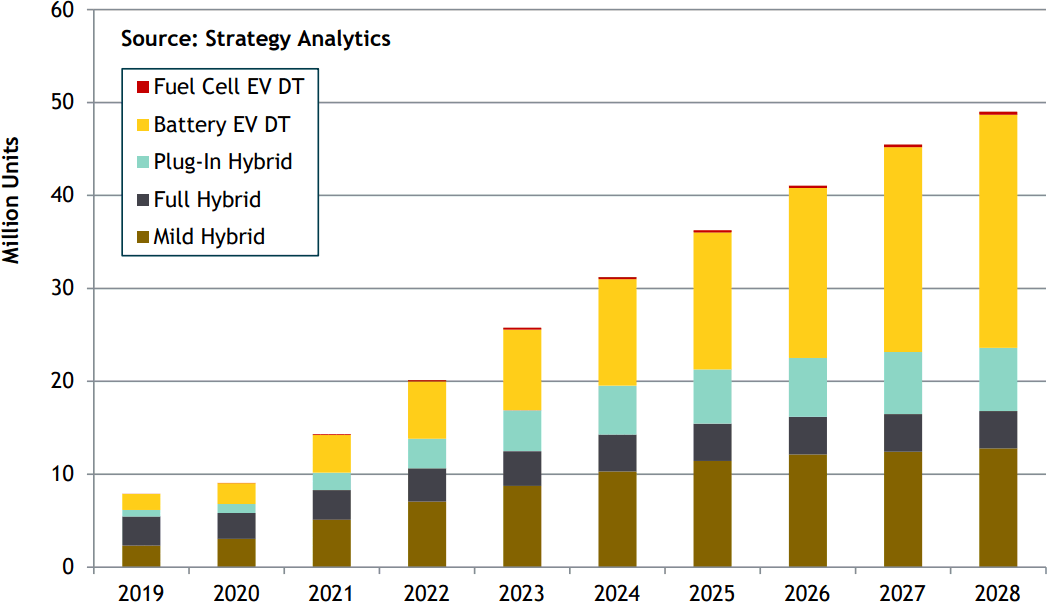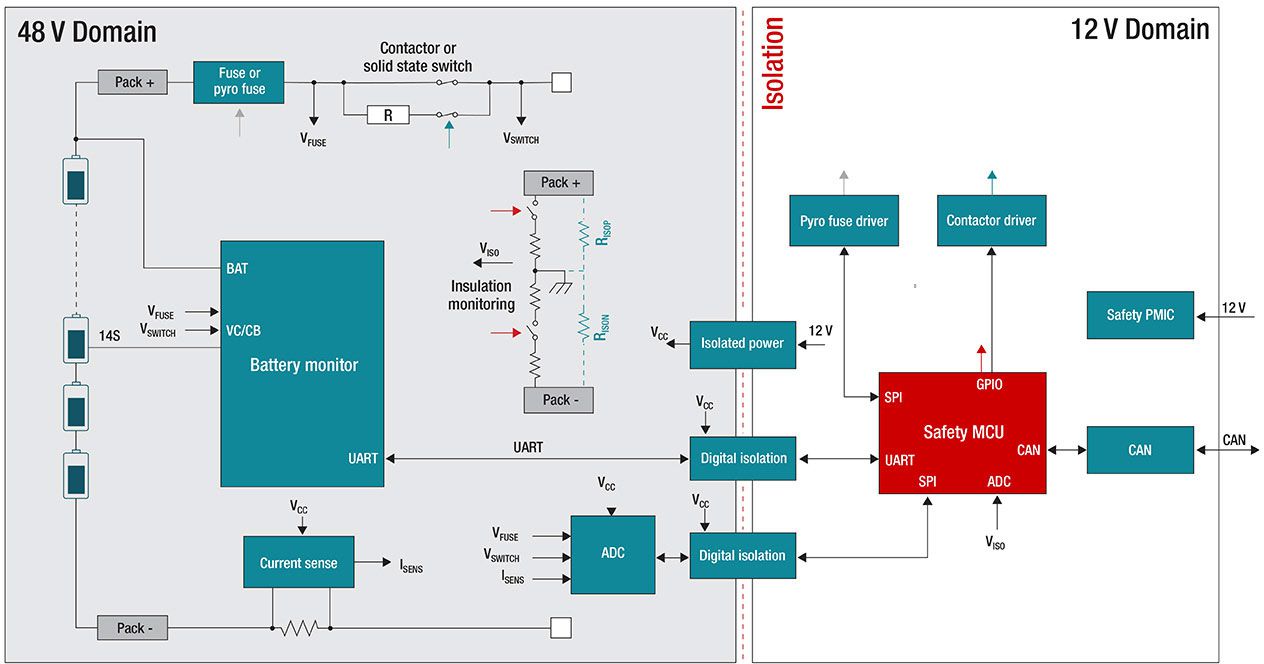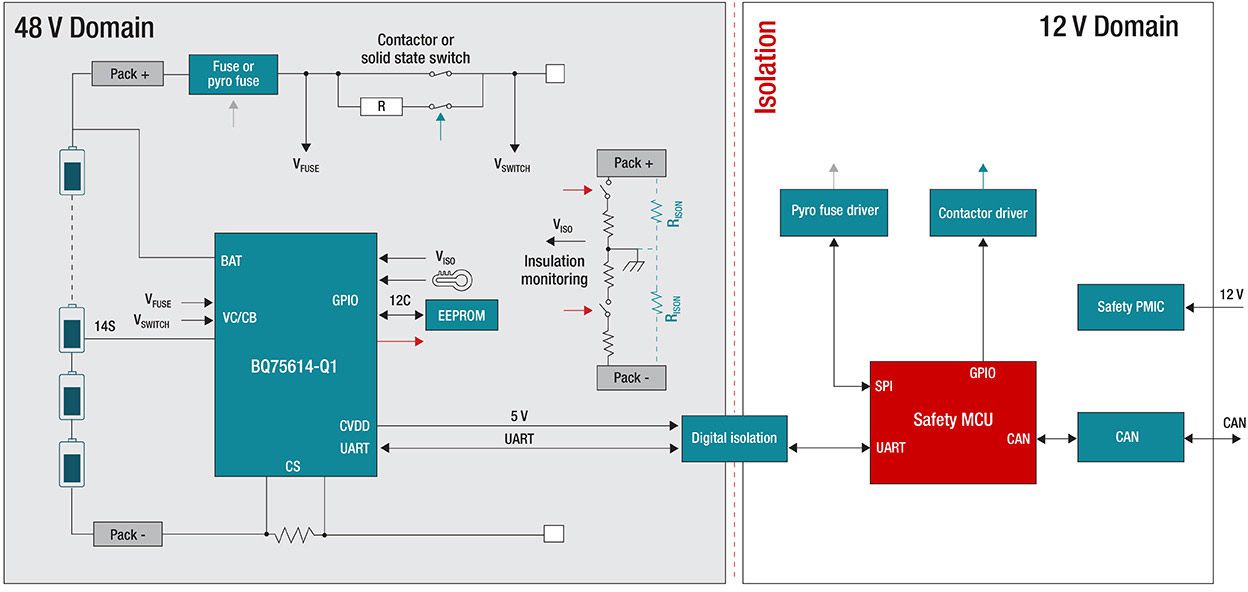SSZT133 september 2021 BQ75614-Q1 , BQ79614-Q1 , ISO6721-Q1
On our way to zero-emission transportation, hybrid electric vehicles (HEV) present a natural transition from internal combustion engines (ICE) to battery electric vehicle (BEV). This transition period will take years, and brings in several types of hybrid vehicles depending on the level of electrification. On one end, we have mild hybrid vehicles with typically a 48-V battery supporting limited electric propulsion. On the other hand, we have plug-in hybrids with electric-only propulsion and an on-board charger (OBC).
Latest predictions show that the 48-V mild-hybrid vehicles will dominate the HEV/BEV market, as shown in Figure 1. Consumer preferences are driving this demand, and as such, automakers must be able to change the existing vehicle architectures enough to meet emissions regulations without incurring the expense and time of a complete redesign.
 Figure 1 Global xEV Market Trend; source: Strategy Analytics
Figure 1 Global xEV Market Trend; source: Strategy AnalyticsFacing fierce competition, the HEV manufacturers seek the best solutions while balancing cost and performance. In this article, we’ll discuss how choosing a smart battery monitor with integrated features can help you achieve design advantages such as high-precision battery monitoring, high levels of functional safety and BOM savings to name a few.
48-V HEV Battery Management System
Today’s mild hybrid vehicles typically have a downsized ICE, along a 48-V battery providing limited electric propulsion and supporting high-power loads such as electronic torque assist. This 48-V battery requires a battery management system (BMS) for monitoring, protection, power distribution and other auxiliary functions. For safety reasons, the traditional low-voltage 12-V battery is still present.
The 48-V BMS consists of a battery control unit (BCU) on the 12-V side, and a cell supervision unit (CSU) combined with a battery distribution unit (BDU) on the 48-V side, as shown in Figure 1. The engine control unit (ECU) is separated and controls the BMS via CAN interface. For increased safety, BCU and CSU are typically isolated.
 Figure 2 Typical BMS for 48-V HEV
Figure 2 Typical BMS for 48-V HEVCommon BMS functions are:
- Voltage monitoring and balancing of the individual battery cells
- Voltage and current measurement of the whole battery pack
- Battery temperature monitoring
- Power switching and distribution
- Insulation monitoring
Evidently, the central part of the BMS is the battery monitoring and balancing IC. However, not all BMS functions can necessarily be performed by the battery monitor. For example, if the current measurement is not implemented in the battery monitor, an additional current monitor is required, together with an ADC and a digital isolator like the ISO6721-Q1. In order to lower the system cost, it is desirable to have this function integrated in the battery monitor itself.
Shrink Solution Size, Save Time and BOM
If all BMS functions can be performed in the battery monitor, significant savings in development time, solution size and BOM cost can be achieved. Figure 3 shows a 48-V BMS system built around the BQ75614-Q1, a 14-S automotive precision battery monitor, balancer, protector and integrated current sensing with ASIL-D compliance.
 Figure 3 BQ75614-Q1 Based BMS for 48-V HEV
Figure 3 BQ75614-Q1 Based BMS for 48-V HEVCompared to Figure 2, we can see significant reduction in component count. Integrated current sensing, cell balancing, LDO and fuse/switch monitoring save the cost of additional external components. Flexible general-purpose input/output (GPIO) pins are available to extend the functionality by providing I2C interface, or expanding the number of ADC inputs, for example to measure the battery temperature using NTC thermistors.
High voltage accuracy is crucial for compatibility with increasingly popular lithium iron phosphate (LFP) batteries. When it comes to the accuracy, the BQ75614-Q1 achieves high voltage accuracy of 2 mV. High current accuracy of 0.3% with inherent voltage synchronization allows for more accurate State-of-Charge (SoC) and State-of-Health (SoH) estimation, extending the battery range.
The BQ79614-Q1 has built-in redundancy path for voltage, temperature and current diagnostics, leading to functional safety compliance. Documentation is available to aid ISO 26262 system design and achieve functional safety system requirements up to ASIL D level on cell voltage, current and temperature measurements and communication, and up to ASIL B level on over/under-voltage and over/under-temperature protection. The device also features the capability to complete fault detection time interval (FDTI) within 100 ms by using several built-in diagnostics, freeing up the MCU to complete other tasks.
The BQ75614-Q1 shares several features with the stackable BQ7961x-Q1 family for high-voltage BMS including package, pinout, functional control and register map. As such, the hardware and software developed for the BQ75614-Q1 can be easily ported to other devices in the family, saving development time.
It is clear that the fast growing HEV market requires BMS solutions that are more competitive in terms of cost and performance. Only by providing innovative parts with improved performance, added functionalities and increased level of integration, leading to smarter BMS, can solve this challenge.
Additional Resources
- Stay up to date with the latest TI BMS designs: https://www.ti.com/solution/battery-management-system-bms
- Find out more about the TI battery monitoring solutions: https://www.ti.com/power-management/battery-management/overview.html
- Visit the BQ75614-Q1 product page: https://www.ti.com/product/BQ75614-Q1